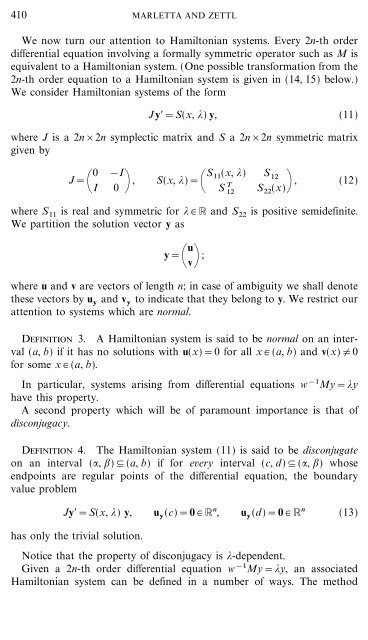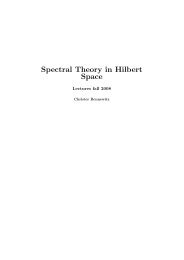The Friedrichs Extension of Singular Differential Operators
The Friedrichs Extension of Singular Differential Operators
The Friedrichs Extension of Singular Differential Operators
Create successful ePaper yourself
Turn your PDF publications into a flip-book with our unique Google optimized e-Paper software.
410 MARLETTA AND ZETTL<br />
We now turn our attention to Hamiltonian systems. Every 2n-th order<br />
differential equation involving a formally symmetric operator such as M is<br />
equivalent to a Hamiltonian system. (One possible transformation from the<br />
2n-th order equation to a Hamiltonian system is given in (14, 15) below.)<br />
We consider Hamiltonian systems <strong>of</strong> the form<br />
Jy$=S(x, *) y, (11)<br />
where J is a 2n_2n symplectic matrix and S a2n_2n symmetric matrix<br />
given by<br />
J= \ 0<br />
I<br />
&I<br />
0 + , S(x, *)= \ S11(x, *)<br />
S T<br />
12<br />
S 12<br />
, (12)<br />
S22(x)+ where S 11 is real and symmetric for * # R and S 22 is positive semidefinite.<br />
We partition the solution vector y as<br />
u<br />
y= \ v+ ;<br />
where u and v are vectors <strong>of</strong> length n; in case <strong>of</strong> ambiguity we shall denote<br />
these vectors by u y and v y to indicate that they belong to y. We restrict our<br />
attention to systems which are normal.<br />
Definition 3. A Hamiltonian system is said to be normal on an interval<br />
(a, b) if it has no solutions with u(x)=0 for all x #(a, b) and v(x){0<br />
for some x #(a, b).<br />
In particular, systems arising from differential equations w &1 My=*y<br />
have this property.<br />
A second property which will be <strong>of</strong> paramount importance is that <strong>of</strong><br />
disconjugacy.<br />
Definition 4. <strong>The</strong> Hamiltonian system (11) is said to be disconjugate<br />
on an interval (:, ;) (a, b) if for every interval (c, d) (:, ;) whose<br />
endpoints are regular points <strong>of</strong> the differential equation, the boundary<br />
value problem<br />
Jy$=S(x, *) y, u y(c)=0 # R n , u y(d)=0 # R n<br />
has only the trivial solution.<br />
(13)<br />
Notice that the property <strong>of</strong> disconjugacy is *-dependent.<br />
Given a 2n-th order differential equation w &1 My=*y, an associated<br />
Hamiltonian system can be defined in a number <strong>of</strong> ways. <strong>The</strong> method



